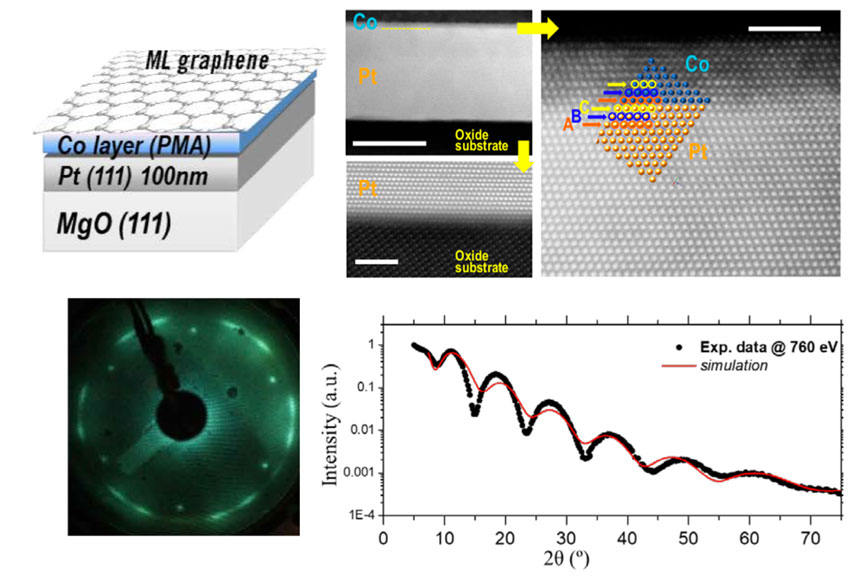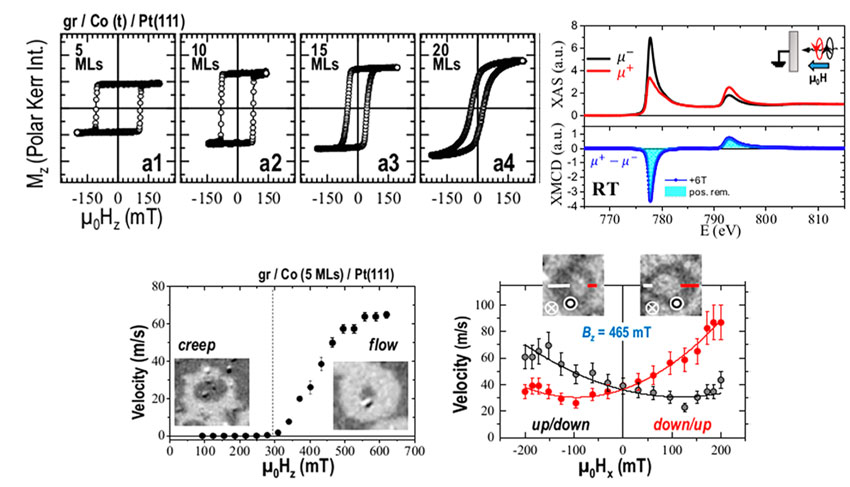Cerdanyola del Vallès, 27th September 2018. A major challenge for future spintronics is to develop suitable spin transport channels with long spin lifetime and propagation length. Graphene can meet these requirements, even at room temperature. On the other side, taking advantage of the fast motion of chiral textures, that is, Néel-type domain walls and magnetic skyrmions, can satisfy the demands for high-density data storage, low power consumption, and high processing speed. The integration of graphene as an efficient spin transport channel in the chiral domain walls technology depends on the ability to fabricate graphene-based perpendicular magnetic anisotropy (PMA) systems with tailored interfacial Spin Orbit Coupling (SOC).
Studies on graphene-based magnetic systems are not abundant and, typically, make use of metallic single crystals as substrates which jeopardize the exploration of their transport properties (since the current is drained by the substrate). To solve this challenge, the IMDEA Nanociencia leading team succeeded to fabricate high-quality epitaxial asymmetric gr/Co/Pt(111) structures grown on (111)-oriented oxide substrates. The quality of the interfaces was checked by low-energy electron diffraction and also by advanced high-resolution transmission microscopy at the Universidad Complutense de Madrid (UCM) microscopy centre and resonant X-ray specular reflectivity at BOREAS beamline at ALBA (see fig.1). The magnetic anisotropy and properties were investigated by magneto-optical Kerr magnetometry in IMDEA and Universidad Autónoma de Madrid (UAM) and complemented with element resolved XMCD magnetometry also at BOREAS beamline. Finally, the chirality of the magnetic domain walls was analysed using a customized magneto-optical Kerr effect microscope and pulse field electronics in collaboration with the team at Institut Néel in Grenoble.

Figure 1: Illustration of the high-quality sample structures fabricated by LEED (IMDEA/UAM), HLTEM (UCM) and resonant X-ray reflectivity (ALBA, BOREAS beamline).
The results proved the high-quality of the samples with flat surfaces and sharp interfaces, a graphene-induced enhancement of the perpendicular magnetic anisotropy up to 4 nm thick Co films and verify the chiral left-handed Néel-type character of the domain walls in the stack, which get stabilized by the effective Dzyaloshinskii–Moriya interaction (DMI). As a conclusion, the experiments showed a sizable DMI at the gr/Co interface, which is described in terms of a conduction electron mediated Rashba–DMI mechanism and points opposite to the spin orbit coupling-induced DMI at the Co/Pt interface.
In addition, the presence of graphene results in (i) a surfactant action for the Co growth, producing an intercalated, flat, highly perfect face-centered cubic film, pseudomorphic with Pt and (ii) an efficient protection from oxidation. The magnetic chiral texture is stable at room temperature and grown on insulating substrate. These findings open new routes to control chiral spin structures using interfacial engineering in graphene-based systems for future spin-orbitronics devices fully integrated on oxide substrates.

Figure 2: (top) Illustration of the Kerr (IMDEA/UAM) and XMCD (ALBA, BOREAS beamline) magnetometries; (bottom) the key microscopy measurements (Institut Néel) that reveal the chiral nature of the Néel domain walls and allow to deduce the magnitude of the DM Interaction, from which the contribution from the Graphene/Cobalt interface was obtained.
Acknowledgments: This work has been supported by MINECO (Ministerio de Economiá y Competitividad) through FLAGERA Graphene Flagship ("SOgraph" No. PCIN-2015-111) and through Projects FIS2016-78591-C3-1- R (SKYTRON), FIS2015-67287-P, , MAT2015-66888-C3-3- R, MAT2014-59315-R, FIS2013-45469-C4-3-R, FIS2016- 78591-C3-2-R (AEI/FEDER, UE) and by the Comunidad de Madrid through Project S2013/MIT-2850 NANOFRONT- MAG-CM. Financial support from the ERC PoC2015 MAGTOOLS is also acknowledged. IMDEA-Nanociencia acknowledges support from the "Severo Ochoa" Program for Centres of Excellence in R&D (MINECO, Grant SEV-2016- 0686).




